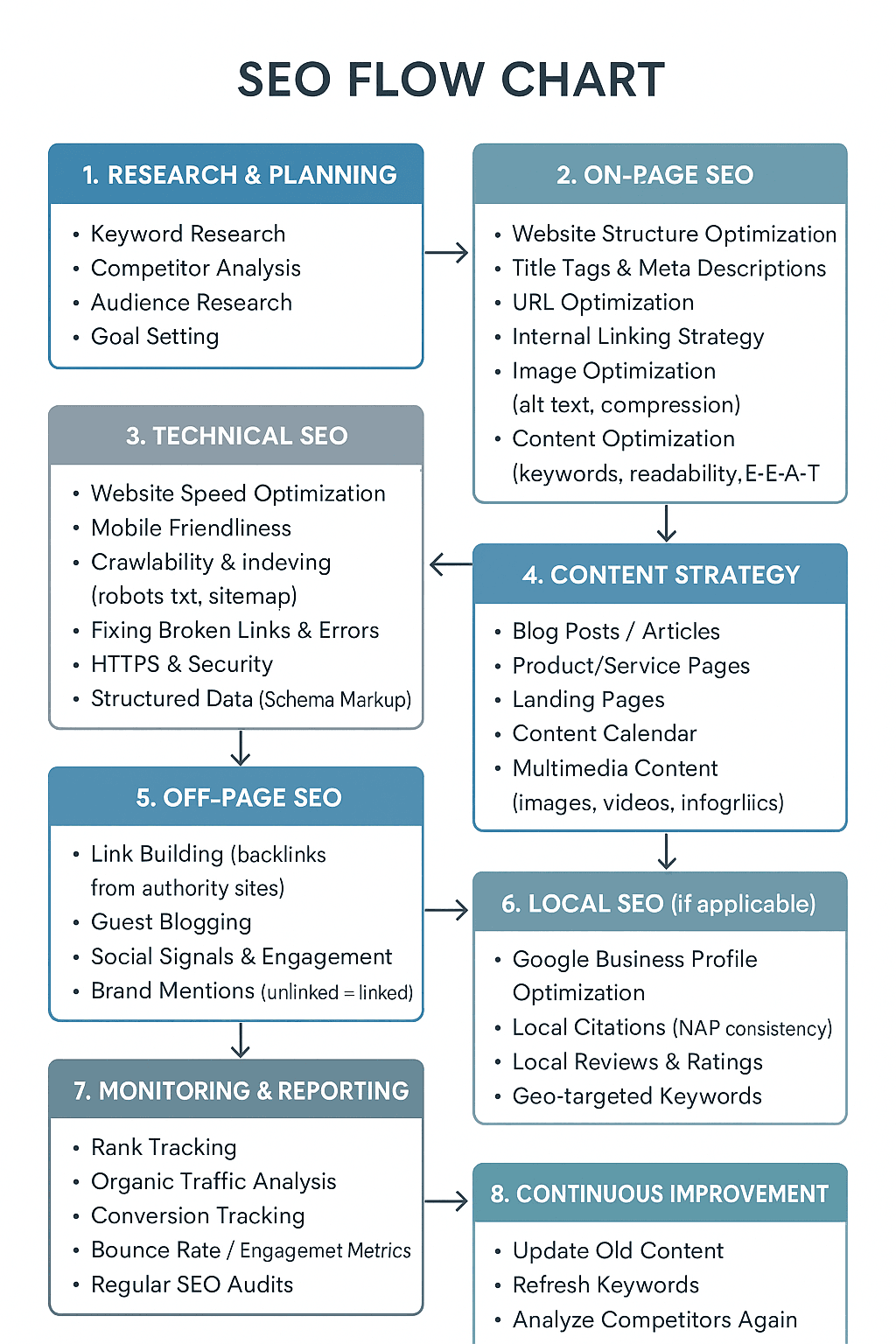Here’s a clear SEO Flow Chart that outlines the step-by-step process of Search Engine Optimization Marketing:
Transform your website’s visibility with this comprehensive SEO roadmap that guides you through every critical step of search engine optimization.
🎯 START HERE: SEO Foundation
↓
Phase 1: Keyword Research & Strategy
🔍 KEYWORD DISCOVERY
↓
📊 Analyze Search Volume & Competition
↓
🎯 Select Primary & Secondary Keywords
↓
📝 Create Keyword Mapping Document
Key Actions:
- Research competitor keywords using tools like SEMrush or Ahrefs
- Identify long-tail opportunities with lower competition
- Map keywords to specific pages on your website
Decision Point: Do you have a solid keyword foundation?
- ✅ YES → Proceed to Technical SEO
- ❌ NO → Return to keyword research
Phase 2: Technical SEO Audit
🔧 TECHNICAL FOUNDATION
↓
⚡ Site Speed Optimization
↓
📱 Mobile Responsiveness Check
↓
🗂️ URL Structure & Site Architecture
↓
🔍 Crawlability & Indexation
Critical Technical Elements:
- Fix broken links and 404 errors immediately
- Optimize Core Web Vitals for better user experience
- Implement SSL certificates for security
- Create XML sitemaps and submit to search engines
Phase 3: On-Page Optimization
📄 CONTENT OPTIMIZATION
↓
🏷️ Title Tags & Meta Descriptions
↓
📝 Header Structure (H1, H2, H3)
↓
🖼️ Image Alt Text & Optimization
↓
🔗 Internal Linking Strategy
On-Page Checklist:
- Craft compelling title tags (50-60 characters)
- Write persuasive meta descriptions (150-160 characters)
- Use keywords naturally in headers and content
- Optimize images with descriptive alt text
Decision Point: Is your on-page SEO optimized?
- ✅ YES → Move to Content Strategy
- ❌ NO → Refine on-page elements
Phase 4: Content Strategy Development
✍️ CONTENT PLANNING
↓
📅 Editorial Calendar Creation
↓
🎯 Topic Cluster Development
↓
📊 Content Gap Analysis
↓
🔄 Content Optimization & Updates
Content Strategy Actions:
- Develop pillar pages around main topics
- Create supporting cluster content that links back to pillars
- Regularly update existing content to maintain freshness
- Focus on user intent rather than just keywords
Phase 5: Link Building Campaign
🔗 LINK ACQUISITION
↓
🎯 Identify Link Opportunities
↓
📧 Outreach & Relationship Building
↓
📄 Guest Posting & Collaborations
↓
📊 Monitor Link Quality & Growth
Link Building Tactics:
- Create linkable assets like infographics and research studies
- Build relationships with industry influencers
- Pursue high-quality guest posting opportunities
- Monitor competitor backlinks for new opportunities
Warning: Avoid low-quality link schemes that can harm your rankings
Phase 6: Monitoring & Optimization
📈 PERFORMANCE TRACKING
↓
🔍 Rank Monitoring
↓
📊 Traffic Analysis
↓
🔄 Continuous Optimization
↓
📋 Monthly SEO Reports
Essential Monitoring Tools:
- Google Analytics for traffic insights
- Google Search Console for search performance
- Rank tracking tools for keyword positions
- Backlink monitoring for link profile health
🎯 SEO Success Indicators
Monthly Review Checklist:
- Organic traffic growth month-over-month
- Keyword ranking improvements for target terms
- Backlink profile expansion with quality links
- Technical issues resolved promptly
- Content performance meeting engagement goals
🚨 Red Flags to Avoid
Never Do These:
- ❌ Keyword stuffing in content
- ❌ Buying low-quality backlinks
- ❌ Ignoring mobile optimization
- ❌ Neglecting page load speeds
- ❌ Duplicating content across pages
🎉 Next Steps
Ready to dominate search results? Start with Phase 1 and work systematically through each stage. Remember, SEO is a marathon, not a sprint – consistency and patience yield the best results.
🚀 Begin Your SEO Journey Today
Your website’s transformation starts with a single step. Which phase will you tackle first?
💡 Pro Tip: Bookmark this flow chart and revisit it monthly to ensure you’re staying on track with your SEO strategy. Success comes from following the process consistently, not from shortcuts.
An SEO flow chart visually outlines the essential steps and decision points in the SEO process, helping teams efficiently manage website optimization, from technical audits to ongoing content updates and reporting.

🔹 SEO Flow Chart
1. Research & Planning
- Keyword Research → Competitor Analysis → Audience Research → Goal Setting
2. On-Page SEO
- Website Structure Optimization
- Title Tags & Meta Descriptions
- URL Optimization
- Internal Linking Strategy
- Image Optimization (alt text, compression)
- Content Optimization (keywords, readability, E-E-A-T)
3. Technical SEO
- Website Speed Optimization
- Mobile Friendliness
- Crawlability & Indexing (robots.txt, sitemap)
- Fixing Broken Links & Errors
- HTTPS & Security
- Structured Data (Schema Markup)
4. Content Strategy
- Blog Posts / Articles
- Product/Service Pages
- Landing Pages
- Content Calendar
- Multimedia Content (images, videos, infographics)
5. Off-Page SEO
- Link Building (backlinks from authority sites)
- Guest Blogging
- Social Signals & Engagement
- Brand Mentions (unlinked → linked)
6. Local SEO (if applicable)
- Google Business Profile Optimization
- Local Citations (NAP consistency)
- Local Reviews & Ratings
- Geo-targeted Keywords
7. Monitoring & Reporting
- Rank Tracking
- Organic Traffic Analysis
- Conversion Tracking
- Bounce Rate / Engagement Metrics
- Regular SEO Audits
8. Continuous Improvement
- Update Old Content
- Refresh Keywords
- Analyze Competitors Again
- Adjust SEO Strategy Based on Data
A visual flowchart diagram (image/graphic) for SEO Marketing

Key SEO Flow Chart Steps
- Begin with a site audit to identify errors such as broken links, coding, design, or speed issues.
- Perform in-depth keyword and competitor research to inform content and optimization strategies.
- Get stakeholder or client approval on strategy before proceeding with on-page optimization.
- Execute on-page optimization, which includes optimizing meta tags, URLs, images, and website navigation for SEO best practices.
- Carry out off-page optimization such as content promotion, link building, and directory submissions to enhance authority.
- Continuously monitor traffic and keyword rankings using analytics and SEO tools; use insights for ongoing improvements.
- Regularly report progress and results, and loop back into another audit and optimization cycle for continuous improvement.
Example: Typical SEO Workflow
- Site Audit
- Keyword Research
- Competitor Analysis
- Strategy Approval
- On-Page Optimization
- Off-Page Activities
- Performance Monitoring
- Review/Reporting
SEO flow charts can also be tailored for specialized decisions, like whether to prune or update content, manage international SEO, or respond to Google updates. These visuals are valuable for both strategizing and communicating SEO plans—especially to stakeholders unfamiliar with technical SEO
This structured, cyclical approach helps maximize website visibility, ensure ongoing improvements, and align team efforts for long-term search engine success
Learn More – Maxsdigit